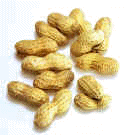
Peanuts
Arachis hypogaea From South America
not really a nut but legume;
also called ground nuts, monkey nut, goober, earth almond, grass nut,
earth pistachio, pindar, mandois, earth cacoa.
Peanuts are planted
after the last frost in April, when soil temperatures reach 65° to
70° Fahrenheit. The peanut itself is also the seed. Specially-grown
and treated peanut kernels from the previous year's crop are planted two
inches deep, approximately one to two inches apart in rows.
The peanut plant is unusual because it flowers above the
ground, but fruits below the ground. Peanut seeds crack the soil about 10
days after planting and grow into a green oval-leafed plant about 18
inches tall. Delicate yellow flowers form on the plant about 40 days after
planting. The flowers pollinate themselves, then the petals fall off as
the peanut ovary begins to form.
 This budding ovary, called a "peg," grows away from the
plant on a vine and penetrates the soil.
This budding ovary, called a "peg," grows away from the
plant on a vine and penetrates the soil.
There are four basic types of peanuts grown in the U.S.:
Runner, Virginia, Spanish and Valencia.
Market Forms Peanuts are available in the
shell or shelled-fresh, roasted or roasted and salted, loose or in
packages.
Serve for snacks, as peanut
oil, peanut butter, in cookies, as an icing, in confections and baking.
Complimentary Condiments and Flavors Chocolate,
bacon, jellies and jams, marmalade, butter, marshmallows, curries,
chicken, pork.
* Information supplied by the Peanut Advisory
Board, 1025 Sugar Pike Way, Canton, GA 30115





























 .
.